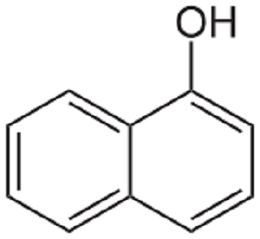HI! I’M ELEMENT AI.
1-Naphthol

Product Description
1-Naphthol, also known as α-naphthol, is a chemical compound with various industrial applications due to its unique properties.
Product:
1-Naphthol
CAS:
90-15-3
Synonym:
α-naphthol; 1-Hydroxynaphthalene
Structure:

Typical Characteristics
Appearance
White to off-white solid
Boiling point
278-280 °C
Density
1.0954 g/cm3
Flash Point
153 °C
Melting point
94-96 °C
Molecular Weight
144.17
Odor
Phenolic odor
Purity
≥99%
Refractive index
1.6224
Uses, Applications & Markets
Key applications
Markets
get a quote



1-Naphthol used in many
industry applications
1-Naphthol, also known as α-naphthol, is a chemical compound with various industrial applications due to its unique properties. Here are some of its main uses:
- Dye Intermediate: 1-Naphthol is a key intermediate in the synthesis of azo dyes, which are widely used in the textile, printing, and leather industries. It undergoes diazotization and coupling reactions with aromatic amines to produce a wide range of colored dyes with different shades and properties. These azo dyes are utilized to impart vibrant and permanent colors to textiles, paper, plastics, and other materials.
- Pharmaceuticals: 1-Naphthol is employed as a precursor in the synthesis of various pharmaceutical compounds and active ingredients. It serves as a starting material for the production of pharmaceutical intermediates, such as naphtholsulfonic acids, which are used in the manufacture of drugs, agrochemicals, and fine chemicals. Additionally, 1-naphthol derivatives exhibit biological activity and are investigated for their potential therapeutic applications.
- Antioxidant: 1-Naphthol possesses antioxidant properties and is utilized as a stabilizer in rubber and plastic formulations to prevent degradation caused by exposure to heat, light, and oxygen. It scavenges free radicals and reactive oxygen species, inhibiting oxidative reactions that lead to polymer degradation, discoloration, and loss of mechanical properties. 1-Naphthol-based antioxidants enhance the thermal stability, weatherability, and aging resistance of polymeric materials.
- Herbicide Intermediate: 1-Naphthol is a precursor in the synthesis of herbicides and plant growth regulators used in agriculture and horticulture. It undergoes various chemical transformations to produce active ingredients with herbicidal or growth-regulating properties. These compounds are applied to crops, lawns, and ornamental plants to control weeds, promote growth, and improve crop yields.
- Chemical Reagent: 1-Naphthol is employed as a chemical reagent in analytical chemistry, organic synthesis, and laboratory research. It serves as a nucleophile, electrophile, or catalyst in various chemical reactions, including diazotization, oxidation, halogenation, and condensation reactions. 1-Naphthol derivatives are utilized as indicators, stains, and fluorescent probes for detecting and analyzing different compounds and functional groups.
- Photographic Chemicals: 1-Naphthol has been historically used in the photographic industry as a developing agent and coupler in black-and-white and color photographic processes. It participates in redox reactions with silver halide crystals, reducing them to metallic silver and forming image dyes. 1-Naphthol derivatives are employed as developers, toners, and color couplers in various photographic emulsions and printing papers.
- Chemical Intermediates: 1-Naphthol serves as a versatile building block in organic synthesis, enabling the preparation of a wide range of functionalized derivatives with diverse chemical properties. It undergoes numerous chemical transformations, including nitration, sulfonation, acylation, and alkylation reactions, to produce intermediates and final products used in the synthesis of agrochemicals, flavorings, fragrances, and specialty chemicals.
- Laboratory Solvent: 1-Naphthol is sometimes used as a solvent or solvent additive in laboratory research and chemical processes. It is employed to dissolve, dilute, or suspend various organic and inorganic compounds for analytical testing, extraction, purification, and synthesis. 1-Naphthol solutions are utilized in chromatography, spectrophotometry, and other analytical techniques for sample preparation and analysis.
- Wood Preservatives: 1-Naphthol derivatives are incorporated into wood preservatives and timber treatments to protect wood from decay, mold, and insect damage. They penetrate the wood fibers and form chemical complexes that inhibit the growth of wood-destroying organisms, extending the service life of wooden structures, furniture, and outdoor decking.
- Textile Chemicals: 1-Naphthol-based compounds are used in the textile industry as auxiliary agents, finishing agents, and dyeing assistants. They improve the dyeing properties, color fastness, and wash fastness of textile fibers, yarns, and fabrics. 1-Naphthol derivatives enhance the penetration, leveling, and uniformity of dyestuffs during the dyeing and printing processes, resulting in high-quality and durable textile products.